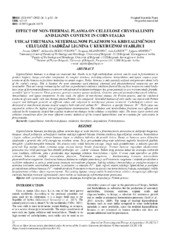Effect of Non-thermal Plasma on Cellulose Crystallinity and Lignin Content in Corn Stalks
Uticaj tretmana netermalnom plazmom na kristaliničnost celuloze i sadržaj lignina u kukuruznoj stabljici
| dc.creator | Grbić, Jovana | |
| dc.creator | Đukić-Vuković, Aleksandra | |
| dc.creator | Mladenović, Dragana | |
| dc.creator | Lazović, Saša | |
| dc.creator | Mojović, Ljiljana | |
| dc.date.accessioned | 2023-03-16T15:17:22Z | |
| dc.date.available | 2023-03-16T15:17:22Z | |
| dc.date.issued | 2022 | |
| dc.identifier.issn | 1821-4487 | |
| dc.identifier.uri | http://TechnoRep.tmf.bg.ac.rs/handle/123456789/6151 | |
| dc.description.abstract | Lignocellulosic biomass is a cheap raw material that, thanks to its high carbohydrate content, can be used in fermentation to produce biofuels, biogas and other compounds. Its complex structure, including cellulose, hemicellulose and lignin, requires prior treatment of the biomass to facilitate hydrolysis to simple sugars. Today, biomass is only partially utilized and generates about 14% of the world ́s energy. This is because the most commonly used physical, chemical and physicochemical treatments are not sustainable. They are energy-consuming but still low in productivity and toxic inhibitors formed during these treatments could hinder later steps of fermentation. Biomass treatment with advanced oxidation techniques has great potential as an environmentally friendly, so-called "green" treatment. These processes generate reactive species (radicals, electrons, ions and peroxides) that attack cellulose, hemicellulose, and lignin components. In this work, the effects of non-thermal plasma, the Fenton process, and the combined treatment of corn stalks with non-thermal plasma/Fenton were compared. Grounded biomass of corn stalks was mixed with Fenton reagent and hydrogen peroxide at different ratios and subjected to non-thermal plasma treatment. Carbohydrate content was decreased in non-thermal plasma treated samples both with and without Fe2+. However, a specific biomass: Fe2+:H2O2 ratio was required to achieve the highest rate of lignocellulose decomposition. The cellulose and hemicellulose fractions were affected and reduced by the treatments studied but resulted in almost no changes in the cellulose crystallinity index. The lower lignin content and cellulose crystallinity allow for more efficient enzyme hydrolysis of the treated lignocellulose and new options for valorization in fermentations. | sr |
| dc.description.abstract | Lignocelulozna biomasa predstavlja jeftinu sirovinu koja se može koristiti u fermentacionim procesima za dobijanje biogoriva, biogasa i drugih jedinjenja, zahvaljujući visokom sadržaju ugljenih hidrata. Složena struktura, koja uključuje celulozu, hemicelulozu i lignin, zahteva prethodni tretman biomase kojim se olakšava hidroliza do prostih šećera. Danas se biomasa samo delimično eksploatiše i generiše oko 14% energije na svetskom nivou. To je prevashodno zbog male održivosti najčešće korišćenih fizičkih, hemijskih i fizičko-hemijskih tretmana. Ovi procesi troše veliku količinu energije, imaju malu produktivnost, a toksični sporedni proizvodi koji nastaju tokom tretmana mogu ometati kasnije korake fermentacije. Tretman biomase naprednim oksidacionim procesima ima veliki potencijal kao ekološki prihvatljiv, tzv. „zeleni“ tretman. Tokom ovog procesa dolazi do stvaranja reaktivnih vrsta (radikala, elektrona, jona i peroksida), koje napadaju celulozu, hemicelulozu i lignin. U ovom radu upoređeni su efekti tretmana kukuruzne stabljike netermalnom plazmom, Fentonovim reagensom i kombinovanog tretmana netermalnom plazmom/Fentonreagensom.Samlevena biomasa kukuruzne stabljike pomešana je sa Fentonovim reagensom i vodonik peroksidom u različitim odnosima, a zatim je podvrgnuta tretmanu netermalnom plazmom. Sadržaj celuloze i hemiceluloze je značajno smanjen u uzorcima tretiranim netermalnom plazmom i u prisustvu i u odsustvu Fe2+. Ipak, najveći stepen redukcije lignoceluloze je postignut pri određenom odnosu biomasa:Fe2+:vodonik peroksid. Primenjeni tretmani su uticali i na hemiceluloznu frakciju, ostavljajući indeks kristaliničnosti celuloze skoro nepromenjenim. Niži sadržaj lignina i manji indeks kristaliničnosti celuloze omogućavaju efikasniju enzimsku hidrolizu tretirane lignoceluloze i nove načine za valorizaciju u fermentacionim procesima. | sr |
| dc.language.iso | en | sr |
| dc.publisher | National Society of Processing and Energy in Agriculture, Novi Sad | sr |
| dc.relation | info:eu-repo/grantAgreement/MESTD/inst-2020/200287/RS// | sr |
| dc.relation | info:eu-repo/grantAgreement/MESTD/inst-2020/200135/RS// | sr |
| dc.rights | openAccess | sr |
| dc.rights.uri | https://creativecommons.org/licenses/by/4.0/ | |
| dc.source | Journal on Processing and Energy in Agriculture | sr |
| dc.subject | lignocellulose | sr |
| dc.subject | non-thermal plasma | sr |
| dc.subject | oxidation | sr |
| dc.subject | biorefinery | sr |
| dc.subject | degradation | sr |
| dc.subject | Fenton process | sr |
| dc.subject | lignoceluloza | sr |
| dc.subject | netermalna plazma | sr |
| dc.subject | oksidacija | sr |
| dc.subject | biorafinerija | sr |
| dc.subject | degradacija | sr |
| dc.subject | Fenton process | sr |
| dc.title | Effect of Non-thermal Plasma on Cellulose Crystallinity and Lignin Content in Corn Stalks | sr |
| dc.title | Uticaj tretmana netermalnom plazmom na kristaliničnost celuloze i sadržaj lignina u kukuruznoj stabljici | sr |
| dc.type | article | sr |
| dc.rights.license | BY | sr |
| dc.citation.epage | 56 | |
| dc.citation.issue | 2 | |
| dc.citation.rank | M51 | |
| dc.citation.spage | 52 | |
| dc.citation.volume | 26 | |
| dc.identifier.doi | 10.5937/jpea26-36871 | |
| dc.identifier.fulltext | http://TechnoRep.tmf.bg.ac.rs/bitstream/id/16349/Effect_of_non_thermal_pub_2022.pdf | |
| dc.type.version | publishedVersion | sr |

